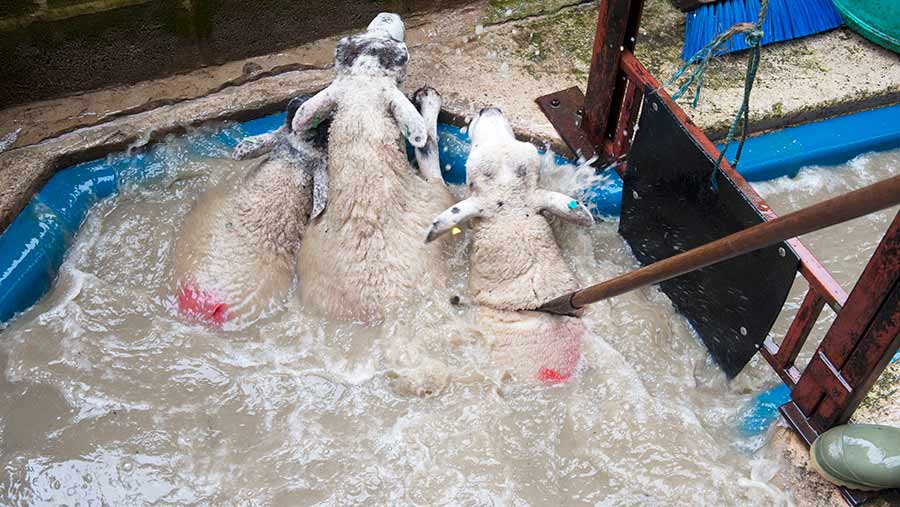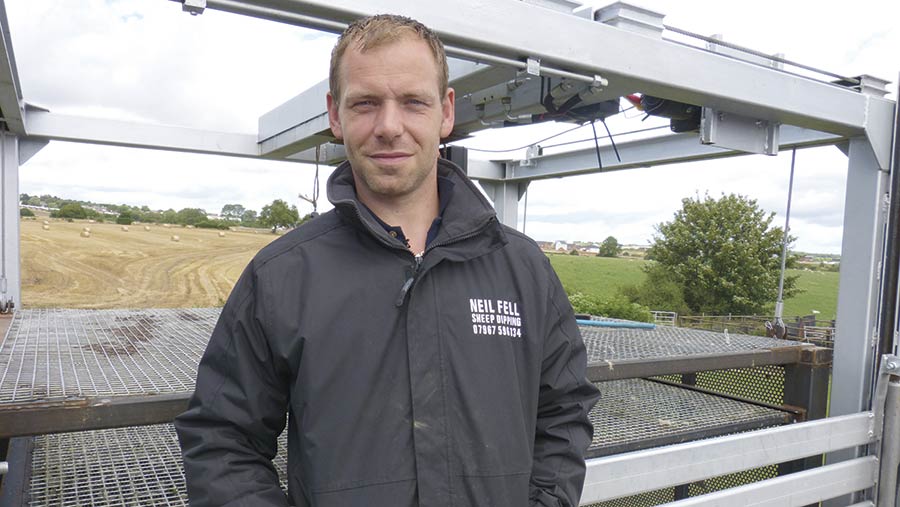Dipping sheep to control scab – what you need to know
 © FLPA/Wayne Hutchinson/REX/Shutterstock
© FLPA/Wayne Hutchinson/REX/Shutterstock Scab appears to be a growing problem in UK flocks and dipping is seeing a revival on UK farms as producers battle to control it.
The first scab resistance to injectable was reported early in 2018. While heavily regulated, plunge dipping sheep in organophosphate (OP) can address more than just scab, says contract sheep dipper Neil Fell.
“Dipping kills both lice and scab, so by dipping your sheep you have covered both parasites anyway,” he explains.
Mr Fell of Nafferton Farm, near Brancepeth, County Durham, has seen growing demand for his mobile sheep dipping services.

Neil Fell
His round has seen a meteoric rise, growing from 2,500 sheep in 2013 to more than 107,000 in 2017.
See also: See Neil Fell’s dipping trailer in action
Last summer he unveiled a bespoke automatic dipping tank fitted to a wagon to double daily throughput from 120-150 sheep an hour to 300 sheep an hour.
“Sheep scab is definitely a worsening problem,” warns Mr Fell. “And the fact that scab is a taboo subject makes the condition harder to address.”
Mr Fell reassures farmers that there is no shame in having scab – a very contagious condition spread by psoroptic mites – and stresses that veterinarians and dipping contractors alike are professional and confidential.
“On many occasions I have gone to dip itchy sheep, with the farmer blaming lice, and it’s turned out to be scab,” says Mr Fell. “The best way [to correctly diagnose the problem] is to get a veterinarian to take a skin and wool sample.”
Below, he answers some questions about dipping for scab.
How can I prepare my flock for dipping?
- No open cuts or wounds – removes the chance of infection
- Ideally shorter fleeces – 21 days after clipping, giving time for nicks and cuts during clipping to heal
- Sheep should be well rested and mobile, with healthy feet
- Fresh, clean water supply – dippers need to replenish dip solution every 96 sheep, which requires water
What are the signs of sheep scab?
- Sheep itching intensely and rubbing themselves repeatedly
- Stamping feet and clawing and biting at body parts
- Also seeing tufts of wool lost in fences or hedges
What protective equipment is required for OP dipping?
- Visor for eye protection
- Respirator mask
- Gloves (300mm rubber)
- Hazard chemical suit or lined waterproofs
- Wellington boots
What key parasites can OP dipping control?
- Sheep scab: Psoroptes ovis mite – can also be controlled with macrocylic lactones
- Blowfly: The most common ecto-parasite in lambs
- Ticks: Generally active between March and October
- Keds: Often mistaken for ticks. Cause irritation, anaemia, hide and wool damage
- Lice: UK sheep can be affected by sheep body lice (Bovicola ovis), which also put them at risk of sheep scab
How do you dip sheep properly?
- Sheep need to be submerged for one minute
- Total submersion must be achieved twice in that minute
What about after dipping?
- It is advised not to shear sheep until three months after dipping
- 14-day interval should be observed between dipping and dosing with drenches containing organophosphorus compounds
- Meat and offal withdrawal of at least 49 days with dipping products.
Safety guidance
For comprehensive guidance on training, industry certificates, hazards, equipment, good practice and setting up a safe dipping system, access the Health and Safety Executive website (PDF).
